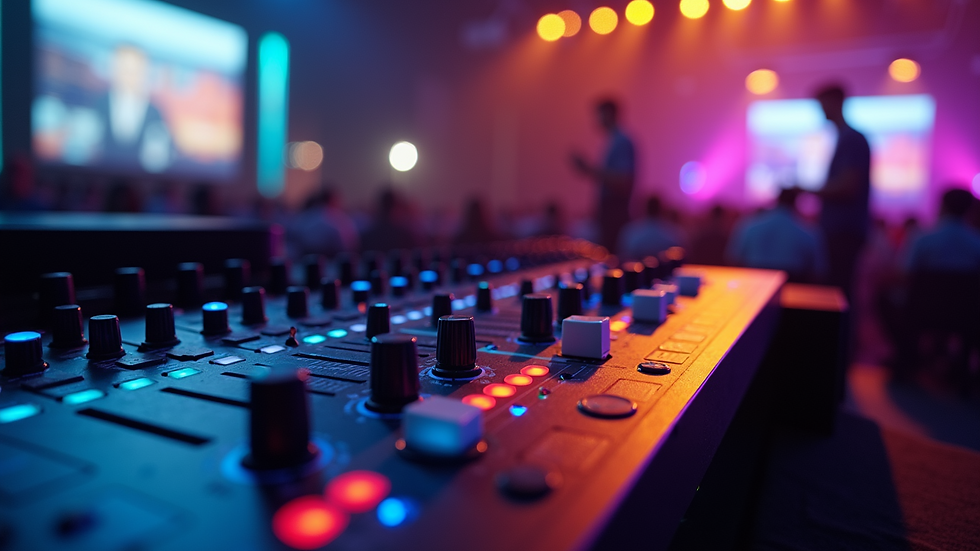How to Choose the Right Audio Setup for Your Event
- GDS Sound & Light
- 6 days ago
- 4 min read
Choosing the right audio setup for your event is crucial to ensure that your message is conveyed clearly and effectively. Whether you're planning a corporate event, a wedding, a concert, or a community gathering, having the appropriate sound system can make all the difference. This blog post will guide you through the essential steps in selecting the right audio setup, providing you with valuable insights and practical recommendations.
Understanding Your Audio Setup Needs
Before diving into specifics, it's essential to understand your audio needs. Start by identifying the type of event you are organizing. Different types of events have varying audio requirements. For example:
Corporate Events: Typically require clear speech projection, so a reliable microphone system is vital.
Weddings: Often need background music along with speech amplification for toasts and ceremonies.
Concerts: Demand high-quality sound that can handle various instruments and vocal performances.
Make a checklist of your requirements, including audience size, venue layout, and the type of content you will present. This will help narrow down your options as you explore different audio setups.

Types of Audio Setups
When it comes to audio setups, there are several types to consider. Familiarizing yourself with these options will aid in making an informed decision.
1. PA Systems
Public Address (PA) systems are ideal for situations where sound needs to fill a large area. These systems typically include microphones, amplifiers, mixers, and speakers. When selecting a PA system, consider the following factors:
Power Output: Ensure it is suitable for the size of your venue.
Microphone Options: Look for both handheld and lapel mics for flexibility.
For larger events, you might opt for a professional PA system, which often delivers superior sound quality.

2. Portable Speakers
If you’re organizing a smaller event, portable speakers could be your best bet. These are easy to transport and set up and can provide sufficient sound for small to medium-sized gatherings. Here are a few points to consider:
Battery-Powered Options: Ideal for outdoor events where access to power might be limited.
Connectivity: Ensure they support Bluetooth or wired connections for various audio sources.
3. Microphone Systems
In many cases, the clarity of your audio will depend significantly on the microphone system you choose. Various options include:
Wired Microphones: Reliable for stationary speakers or presentations.
Wireless Microphones: Great for dynamic speakers who move around the stage.
Before making a selection, consider the feedback and spool-up time of the microphones to ensure optimal sound quality.
How much does a church sound system cost?
The cost of a church sound system can vary significantly based on its capabilities and the size of the venue. Generally, here are some ballpark figures:
Basic System: Approximately $2,000 to $5,000, which may include basic PA equipment and microphones.
Intermediate System: Ranges from $5,000 to $15,000, incorporating multiple speakers and advanced mixing capabilities.
Advanced System: Can exceed $15,000, designed for larger congregations with full support for music, speeches, and video integration.
Budgeting for a sound system should also consider ongoing maintenance and rental options. If your church hosts multiple events, looking into a sound system rental service may be a practical and cost-effective solution.

Factors to Consider When Choosing Equipment
When selecting audio equipment for your event, there are several key factors to keep in mind:
1. Venue Type and Size
The venue plays a significant role in your audio setup. Indoor spaces may require different configurations compared to outdoor locations. Measure the room size and consider the following:
Acoustic Properties: For venues with high ceilings or hard surfaces, you might need additional speakers to avoid echo.
Layout: Understanding the seating arrangement can help in placing the speakers for optimal sound distribution.
2. Budget Constraints
Your budget will ultimately dictate the quality and quantity of your equipment. Allocate sufficient funds not only for purchasing or renting the audio setup but also for any necessary accessories, such as cables, stands, and mixing consoles.
3. Technical Support
For events that heavily depend on audio and visual elements, having technical support is vital. Consider hiring audio engineers or tech-savvy personnel to assist with setup and troubleshooting during the event.
Testing and Finalizing Your Setup
Once you’ve selected your audio equipment, it’s crucial to test everything before the event. Here’s a step-by-step approach:
Set Up at Least 24 Hours in Advance: This gives you ample time to address any issues.
Conduct Sound Checks: Test each microphone and speaker to identify feedback or other sound quality issues.
Adjust Levels: Work with an audio technician, if possible, to ensure that sound levels are balanced across all speakers.
Final checks are just as important as planning the setup. Ensure that all cables are secure and that the equipment is functional.
Event Day Preparation
On the day of the event, your focus should shift towards executing the plan effectively. Here are some tips for success:
Arrive Early: Give yourself plenty of time to handle any last-minute details.
Communicate with Your Team: Ensure everyone involved knows their roles, from setups to troubleshooting.
Have a Backup Plan: Technical issues can arise unexpectedly, so have backup equipment or a contingency plan in place.

Your Pathway to Great Audio Experiences
Selecting the right audio setup for your event doesn’t have to be overwhelming. It requires careful consideration of your specific needs, available resources, and thorough preparation. By following the outlined steps and staying informed, you can achieve a smooth sound experience that resonates with your audience.
With a well-chosen audio setup, your event will not only be heard but also enjoyed. Make your investment count and set the stage for an unforgettable experience.
Comentários